
The Ku Klux Klan, commonly shortened to the KKK or the Klan, is the name of several historical and current American white supremacist, far-right terrorist organizations and hate groups. Various historians, including Fergus Bordewich, have characterized the Klan as America's first terrorist movement. Their primary targets, at various times and places, have been African Americans, Jews, and Catholics.
Ku Klux Klan auxiliaries are organized groups that supplement, but do not directly integrate with the Ku Klux Klan. These auxiliaries include: Women of the Ku Klux Klan, The Jr. Ku Klux Klan, The Tri-K Girls, the American Crusaders, The Royal Riders of the Red Robe, The Ku Klux balla, and the Klan's Colored Man auxiliary.

Zarephath is an unincorporated community and census-designated place (CDP) and located in Franklin Township, in Somerset County, in the U.S. state of New Jersey, about 15 mi (24 km) north of Princeton. As of the 2020 United States census, the CDP's population was 69, an increase of 32 (+86.5%) from the 37 enumerated at the 2010 census.

Alma Bridwell White was the founder and a bishop of the Pillar of Fire Church. In 1918, she became the first woman bishop of Pillar of Fire in the United States. She was a proponent of feminism. She also associated herself with the Ku Klux Klan and was involved in anti-Catholicism, antisemitism, anti-Pentecostalism, racism, and hostility to immigrants. By the time of her death at age 84, she had expanded the sect to "4,000 followers, 61 churches, seven schools, ten periodicals and two broadcasting stations."

WAWZ is a Christian radio station licensed to Zarephath, New Jersey. The station is owned by the non-profit organization Pillar Media, a division of the Pillar of Fire International.

The Westminster Castle, also locally known as "The Pillar of Fire" is a historic landmark located in Westminster, Colorado, northwest of Denver near the intersection of 83rd and Federal. It is listed on the National Register of Historic Places as Westminster University.
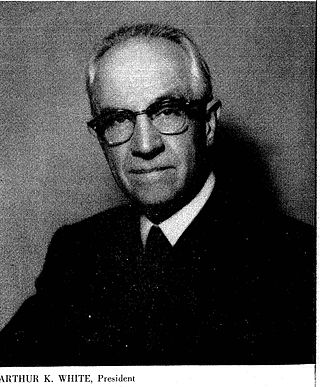
Arthur Kent White was a bishop, and the general superintendent of the Pillar of Fire Church in Zarephath, New Jersey, and the president of Belleview College. The church was started by his mother, Alma Bridwell White, in Denver, Colorado.

The Pillar of Fire International, also known as the Pillar of Fire Church, is a Methodist Christian denomination with headquarters in Zarephath, New Jersey. The Pillar of Fire Church affirms the Methodist Articles of Religion and as of 1988, had 76 congregations around the world, including the United States, as well as "Great Britain, India, Liberia, Malawi, Nigeria, the Philippines, Spain, and former Yugoslavia".

Alma White College was a Bible college in Zarephath, New Jersey from 1921 to 1978. It was an institution of the Pillar of Fire Church. The academic institution is now succeeded by Pillar College.

Arlene Hart White Lawrence was a bishop and the third president and general superintendent of the Pillar of Fire Church, a Protestant denomination which in 1966 operated church congregations, missionary homes, radio stations, publishing operations, farms, schools and colleges from 54 properties around the world. The denomination was founded in Denver, Colorado, by her grandmother, Alma Bridwell White, the first woman to become a bishop in the US. She believed that "activities such as gambling and dancing take time from the really important activities of life". She was the president of all three church radio stations, KPOF in Westminster, Colorado; WAWZ in the Zarephath section of Franklin Township, Somerset County, New Jersey ; and WAKW in Cincinnati, Ohio.
Pillar College is a private evangelical Christian college with the main campus in Newark, New Jersey and educational locations in Somerset, Paterson, Plainfield, and Jersey City. Pillar College is accredited by the Middle States Commission on Higher Education.

Women of the Ku Klux Klan (WKKK), also known as Women's Ku Klux Klan, and Ladies of the Invisible Empire, held to many of the same political and social ideas of the KKK but functioned as a separate branch of the national organization with their own actions and ideas. While most women focused on the moral, civic, and educational agendas of the Klan, they also had considerable involvement in issues of race, class, ethnicity, gender, and religion. The women of the WKKK fought for educational and social reforms like other Progressive reformers but with extreme racism and intolerance.

Arthur Hornbui Bell was an attorney and the Grand Dragon of the Ku Klux Klan in New Jersey.

The Good Citizen was a sixteen-page monthly political periodical edited by Bishop Alma White and illustrated by Reverend Branford Clarke. The Good Citizen was published from 1913 until 1933 by the Pillar of Fire Church at their headquarters in Zarephath, New Jersey in the United States. White used the publication to expose "political Romanism in its efforts to gain the ascendancy in the U.S."
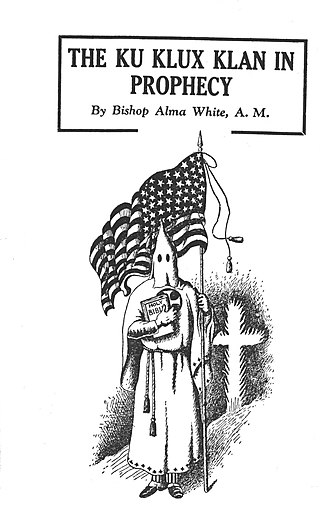
The Ku Klux Klan in Prophecy is a 144-page book written by Bishop Alma Bridwell White in 1925 and illustrated by Reverend Branford Clarke. In the book she uses scripture to rationalize that the Ku Klux Klan is sanctioned by God "through divine illumination and prophetic vision". She also believed that the Apostles and the Good Samaritan were members of the Klan. The book was published by the Pillar of Fire Church, which she founded, at their press in Zarephath, New Jersey. The book sold over 45,000 copies.

Klansmen: Guardians of Liberty was a book published by the Pillar of Fire Church in 1926 by Bishop Alma Bridwell White and illustrated by Branford Clarke. She claims that the Founding Fathers of the United States were members of the Ku Klux Klan, and that Paul Revere made his legendary ride in Klan hood and robes. She said: "Jews are everywhere a separate and distinct people, living apart from the great Gentile masses ... they are not home builders or tillers of the soil." Her book, which contains many anti-Catholic themes, became popular during the United States presidential election of 1928 when Al Smith was the first Catholic presidential candidate from a major party.
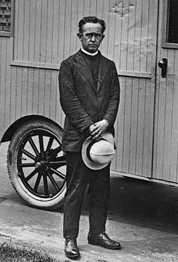
Branford Edward Clarke was an Evangelical preacher, poet and artist who promoted the Ku Klux Klan through his art which was drawn for the Pillar of Fire Church and their publications.
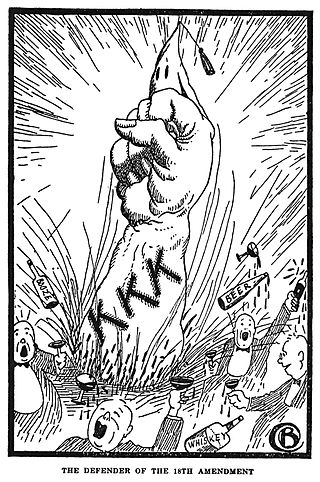
The Ku Klux Klan has had a history in the U.S. state of New Jersey since the early part of the 1920s. The Klan was active in the areas of Trenton and Camden and it also had a presence in several of the state's northern counties in the 1920s. It had the most members in Monmouth County, and operated a resort in Wall Township.
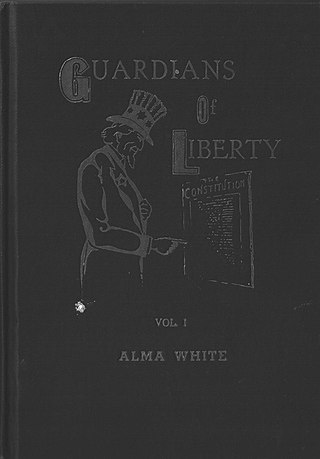
Guardians of Liberty is a three volume set of books published in 1943 by Bishop Alma Bridwell White, author of over 35 books and founder of the Pillar of Fire Church. Guardians of Liberty is primarily devoted to summarizing White's vehement anti-Catholicism under the guise of patriotism. White also defends her historical support of and association with the Ku Klux Klan while significantly but not completely distancing herself from the Klan. Each of the three volumes corresponds to one of the three books White published in the 1920s promoting the Ku Klux Klan and her political views which in addition to anti-Catholicism also included nativism, anti-Semitism and white supremacy. In Guardians of Liberty, White removed most, but not all of the direct references to the Klan that had existed in her three 1920s books, both in the text and in the illustrations. In Volumes I and II, she removed most of the nativist, anti-Semitic and white supremacist ideology that had appeared in her predecessor books. However, in Guardians Volume III, she did retain edited versions of chapters promoting nativism, anti-Semitism and white supremacy.
Known as the Crann Tara in Gaelic, the burning cross represented a signal fire, a method of communication among the clans and the rallying symbol of ancient Scotland and of the Highlanders in times of war.
















